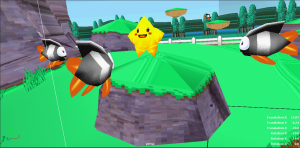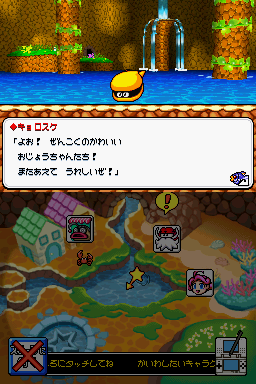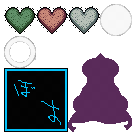Densetsu no Starfy 4/Unused content
Densetsu no Starfy 4 features a variety of unused content in its data. Much of this content includes unused model and sprite data that can be easily be found with a decompiler, and some of the models are surprisingly 'out of place', for example, some Galaga related graphics are hidden in the game. A lot of the models are shared with the Japanese version of Super Princess Peach, also developed by TOSE. Some of the other unused content in the game includes completely unused music and debugging text.[1].
Development text
An unused series of development related text begins at offset 0xE1B600 and finishes at offset 0xE22006. The text contains a list of variables with numbered descriptions and hex codes resembling offsets. Some of the variables are marked unused.
Unused 3D models
- Main article: Densetsu no Starfy 4/Unused content/Unused models
In Densetsu no Starfy 4, various seemingly unused 3D models are stored in the game's G3D directory. The G3D directory is typically used to store files such as the animations and models for the backgrounds of stage maps. The 3D models are defined by four files; NSBMD files that define the model and its dimensions, NSBTX files that define an object's colors and texture and NSBCA files that define how a model should be animated. Not all of the 3D models use all four files because some models may not have associated animations or textures.
Many of the unused models are shared with Japanese versions of Super Princess Peach. It may be worth stressing that Super Princess Peach is a game which was previously developed by TOSE. In the US version of Super Princess Peach the G3D directory was removed with all of the models stored inside it. [2]
'Unused' font
In the extracted ROM there is a font called "stafy2_9b2_small_bmp" with the two other fonts which are used; "stafy4_13b2_2_bmp", "stafy4_13b2_full_bmp". It is smaller than the other fonts. Though the font "stafy2_9b2_small_bmp" appears to be used for the scrolling yellow on the bottom of City screens, technically it isn't, and modifying the font will not change the text. Despite the name, the font is not identical to the font used in Densetsu no Starfy 2.
Partially unused test stage
- Main article: Stage 1 (test) (Densetsu no Starfy 4)
Internally there is a test Stage referred to as Stage 1, sharing its Stage number with Lobber's Villa. This Stage includes many curious maps which appear to have been intentionally added into the game but have graphical and/or layout errors. Among the maps are Spring of Love course copies in Stage 1 (test)-3, with a glitched unidentified map following on from map 9 (for Degil's Castle).
Similar but different test areas are found in Super Princess Peach and The Legendary Starfy.
Hidden text in the Degil Stage 6 cutscene
Hidden text can be found hidden in the texture file ("ddemo s06_l") for the assets associated with the cutscene with Degil prior to entering Flourishing Desert. It reads 'ぼよ' ('pot').
Koopalings
Both Super Princess Peach and Densetsu no Starfy 4 share unused sprite data relating to the seven Koopalings from the Mario series. In Densetsu no Starfy 4, the data is stored in the 'Stage' directory, while in Super Princess Peach, the data is stored in the 'StageBoss' directory.
According to their filenames, Iggy Koopa was meant to appear in Area 1, Morton Koopa Jr. was meant to appear in Area 2, Lemmy Koopa was meant to appear in Area 3, Ludwig von Koopa was meant to appear in Area 4, Roy Koopa was meant to appear in Area 5, Wendy O. Koopa was meant to appear in Area 6 and Larry Koopa was meant to appear in Area 7. Note that the files were copied over from Super Princess Peach to Densetsu no Starfy 4, so it is likely that the Koopalings were only meant to be bosses in Super Princess Peach.
Unused blocks
There are some unused blocks that appear to be based on the Mario series. They are beige 'straight face' blocks, including one type shaped like a square and four types shaped like triangles, which are similar to the blocks that Mario can use to run up walls in Super Mario World. It can be seen in the glitched room with an ID of 261.
Unused music
Densetsu no Starfy 4 features three unused tunes as well as nine dummied out tracks that are copies of Lobber's Villa.
Sequences
In Densetsu no Starfy 4's sound_data.sdat file, there are a total of 68 playable sequences. In the final game, 56 sequences are available in the Legendary Concert - but it is notable that there are an additional three valid tracks that are seemingly unused in the final game. Below are playable videos of the three aforementioned unused tracks.
In addition to the 59 "valid" sequences, there are an additional nine tracks that are copies of Lobber's Villa when they are forcibly played. These will be described in further detail in the 'dummied-out music' section below.
Dummied-out music
The sequences in Densetsu no Starfy 4 are named in the format '[1]-SEQ-[2]'. The first integer is a number that appears to describe the real track, and the second number describes the order that the track appears in the game code.
Below are the list of sequences as they appear in the game's SDAT file.
000-SEQ_000.SSEQ 001-SEQ_001.SSEQ 002-SEQ_002.SSEQ 003-SEQ_003.SSEQ 003-SEQ_003.SSEQ 004-SEQ_004.SSEQ 005-SEQ_005.SSEQ 006-SEQ_006.SSEQ 007-SEQ_007.SSEQ 008-SEQ_008.SSEQ 009-SEQ_009.SSEQ 010-SEQ_010.SSEQ 011-SEQ_011.SSEQ 012-SEQ_012.SSEQ 013-SEQ_013.SSEQ 014-SEQ_014.SSEQ 015-SEQ_015.SSEQ 016-SEQ_016.SSEQ 017-SEQ_017.SSEQ 018-SEQ_018.SSEQ 001-SEQ_019.SSEQ (*) 019-SEQ_020.SSEQ 020-SEQ_021.SSEQ 021-SEQ_022.SSEQ 022-SEQ_023.SSEQ 023-SEQ_024.SSEQ 024-SEQ_025.SSEQ 025-SEQ_026.SSEQ 026-SEQ-027.SSEQ 027-SEQ_028.SSEQ 028-SEQ_029.SSEQ 029-SEQ_030.SSEQ 030-SEQ_031.SSEQ 031-SEQ_032.SSEQ 032-SEQ_033.SSEQ 033-SEQ_034.SSEQ 034-SEQ_035.SSEQ 035-SEQ_036.SSEQ 036-SEQ_037.SSEQ 037-SEQ_038.SSEQ 038-SEQ_039.SSEQ 039-SEQ_040.SSEQ 040-SEQ_041.SSEQ 041-SEQ_042.SSEQ 042-SEQ_043.SSEQ 043-SEQ_044.SSEQ 044-SEQ_045.SSEQ 045-SEQ_046.SSEQ 001-SEQ_047.SSEQ (*) 046-SEQ_048.SSEQ 047-SEQ_049.SSEQ 048-SEQ_050.SSEQ 001-SEQ_051.SSEQ (*) 001-SEQ_052.SSEQ (*) 001-SEQ_053.SSEQ (*) 001-SEQ_054.SSEQ (*) 001-SEQ_055.SSEQ (*) 001-SEQ_056.SSEQ (*) 049-SEQ_057.SSEQ 001-SEQ_058.SSEQ (*) 050-SEQ_059.SSEQ 051-SEQ_060.SSEQ 052-SEQ_061.SSEQ 053-SEQ_062.SSEQ 054-SEQ_063.SSEQ 055-SEQ_064.SSEQ 056-SEQ_065.SSEQ 057-SEQ_066.SSEQ 058-SEQ_067.SSEQ
As shown above, the first integer does not always match the second integer. There are nine SSEQ files that use '001' as the first integer in their filenames when the second integer suggests that they are separate entries. These have been indicated above with an asterisk.
As the number of sequences extends to 68, this may imply that the developers allocated more files for music if they needed to add them. The contents of these nine files are in fact copies of '001-SEQ_001.SSEQ' (Lobber's Villa) that were probably kept as placeholder data.
It may be worth stressing that the dummied-out sequences are unusually ordered, given that they are indexed in between the SSEQ files of used music and the three unused tracks.
Notes
In the Legendary Concert, data exists at the end of track names for a sequence titled "No Tune 58" (Japanese: なしきょく58). However, it appears to be simply a placeholder to mark the end of the Legendary Concert, given that there are a total of 57 songs indexed, including the 'not-unlocked' placeholder, "☆☆☆☆☆☆☆☆☆" which is listed as the first track. The nine additional copies of Lobber's Villa are not indexed in this list.
External links
References
- ↑ Tools used: NDSTool, DSLazy, NSBMD, ConsoleTool3, CrystalTile2, SSEQ2MIDI, VGMTrans v9, NDSSNDEXT, HxD, ArtMoney SE v7.38
- ↑ Super Princess Peach - unused materials
| List of prerelease information | Densetsu no Starfy • Densetsu no Starfy 2 • Densetsu no Starfy 3 • Densetsu no Starfy 4 • The Legendary Starfy |
|---|---|
| Lists of unused content | Densetsu no Starfy • Densetsu no Starfy 2 (test stage) • Densetsu no Starfy 3 (test stage) • Densetsu no Starfy 4 (test stage, unused models) • The Legendary Starfy (Helpful Stuff, test stage) • Test Stages (general information) |
| Unreleased games | Unused balloon/bubble pushing games / Densetsu no Starfy (Game Boy/Color) |
| Events and TV shows | Nintendo Space World (2000, 2001) • World Hobby Fair (2002, 2006) • Oha Suta • E3 (2009) |
| Media with relevant information | Game Boy Encyclopedia • Gekkan Nintendo • Nintendo Dream • Nintendo Power • Nintendo Spaceworld Official Guidebooks • Websites |




